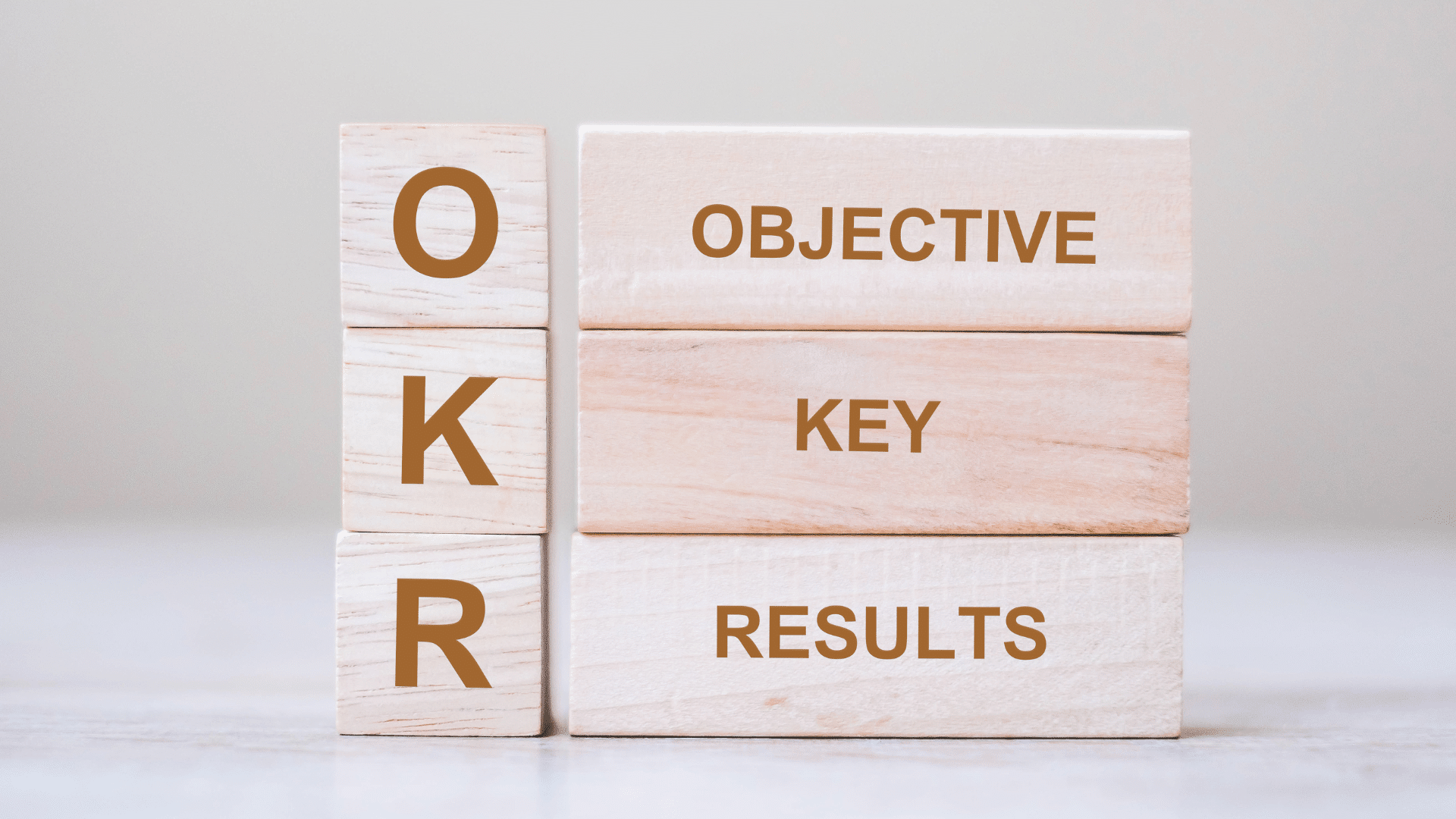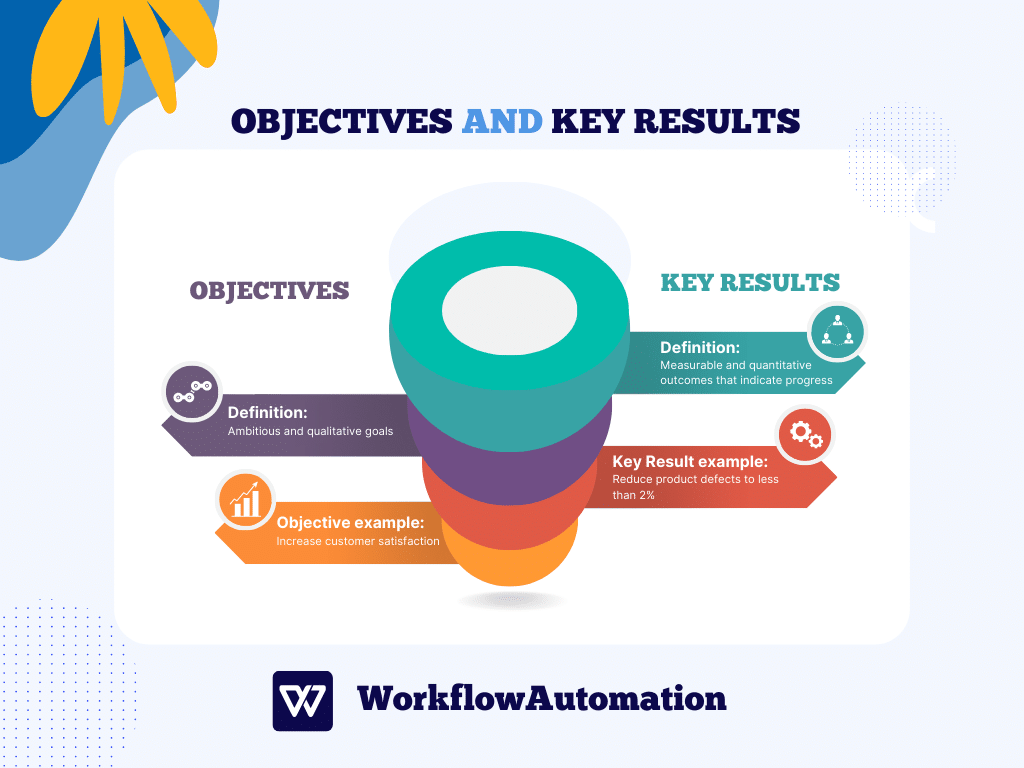Objectives and Key Results (OKRs) are used by many teams, project managers, and individuals to achieve ambitious goals more effectively. However, to discuss goal achievement, it is necessary first to define the objectives and establish a measurement unit to track their progress.
This is where OKR’s methodology comes into play. To experience the benefits of OKRs, understanding the significance and nature of this approach is essential.
Therefore, we have prepared a text to reveal what OKRs are about. Let’s dive in!
What is an OKR?
Objective and Key Results (OKRs) is a goal-setting framework used by organizations, teams, project managers, and individuals to define and track their objectives and the measurable outcomes that indicate the progress toward achieving them.
The method is simple yet effective—objectives set ambitious and qualitative goals, while key results define measurable outcomes that chart the progress toward those objectives.
By aligning everyone’s efforts towards common objectives, the OKRs framework creates cohesion within the organization and team, while success becomes tangible, and everyone can see their contributions to the bigger picture.
Components of OKR
From the OKR definition, you can see that this framework consists of two components—objectives and key results. Let’s explain each individually and provide a few examples.
#1. Objectives
Objectives are the heart of the OKR framework, representing the ambitious and qualitative goals an individual, team, or organization aims to achieve. These objectives are inspiring and challenging and set the direction for everyone’s efforts.
It is crucial to keep objectives clear, concise, and aligned with the overall vision.
Objectives Example:
- Increase customer satisfaction
- Improve product quality
- Expand market presence in new regions
#2. Key Results
Key results are the measurable and quantitative outcomes that indicate progress toward achieving the defined objectives. They provide a specific and data-driven way to track success and ensure everyone is on the right path.
Key Results should be challenging yet attainable, pushing teams to strive for greatness.
Key Results Example:
Objective: Improve product quality
- Key Results 1: Reduce product defects to less than 2%
- Key Results 2: Achieve a product uptime of 99.9%
- Key Results 3: Increase customer-reported product satisfaction to 4.5 out of 5
We hope that you now have a clear picture of the OKR framework and its components. However, the true power of OKRs lies in the combination of objectives and key results. When they work well together, they create a culture focused on results that drive success and growth.
Who Created OKRs?
OKRs were created by Andre Grove, the former CEO of Intel. He developed this framework in the 1970s as a way to drive focus, alignment, and high performance within Intel. The OKR system became highly successful within the company, contributing to its growth and success.
Later, John Doerr, a venture capitalist who worked at Intel, popularized OKRs by introducing them to other Silicon Valley companies, including Google. Google’s adoption of OKRs further solidified its reputation in the tech industry.
The simplicity and effectiveness of OKRs have since led to widespread adoption across various industries and organizations worldwide.
Benefits of Using OKRs
Now, let’s see what benefits the OKR framework are:
#1. OKRs Foster Continuous Improvement
By setting ambitious but achievable objectives and measurable key results, teams are encouraged to innovate and find new ways to reach their goals.
Regular check-ins and progress updates enable teams to adapt their strategies and make data-driven decisions, promoting a dynamic and agile environment that is open to change and improvement.
#2. OKRs Narrow the Focus
One of the primary benefits of OKRs is their ability to narrow the focus on what truly matters. OKRs give individuals and teams clarity and direction by setting goals and specific vital results.
That ensures that everyone is working on the most critical projects and helps prevent the dispersion of resources and energy on tasks that do not contribute significantly to the overall goal.
#3. OKRs Support Strategic Alignment
When OKRs are cascaded from top-level objectives to departmental and individual goals, everyone’s efforts align with the broader strategy and vision.
This alignment boosts collaboration, reduces silos, and ensures all project stakeholders work together towards shared objectives.
#4. OKRs Enhance Transparency and Accountability
When objectives and key results are visible to everyone, tracking progress and identifying potential bottlenecks becomes easier. Individual accountability is also heightened, as team members can see how their contributions impact the overall results.
#5. OKRs Encourage Stretch Goals
OKRs encourage setting stretch goals that push teams beyond their comfort zones. They motivate teams to strive for exceptional performance by aiming high and defining ambitious, vital results. Even if all key results are not achieved, pursuing challenging objectives can lead to significant progress.
OKRs vs. SMART Goals
It’s not uncommon for people to confuse OKRs with KPIs or SMART goals. That is why we’ll shed some light on the differences between both of these, starting with the OKRs vs. SMART goals dilemma first.
While OKRs are a powerful framework for goal-setting, it’s important to note that they differ from SMART goals. SMART goals are another goal-setting framework that emphasizes Specific, Measurable, Achievable, Relevant, and Time-bound objectives.
While both approaches share similarities, OKRs focus on ambitious objectives and measurable key results, whereas SMART goals prioritize specificity and detailed planning.
OKRs vs. KPIs
OKRs and KPIs are key indicators of how work processes function, making it easier for you to organize and track your work. Therefore, these approaches complement each other perfectly.
However, when considering the choice between OKRs vs. KPIs, explore the purpose of each and what sets them apart to make the best decision.
The key distinction is that OKRs offer a clear roadmap and the capability to actively track progress, while KPIs are limited to monitoring progress alone.
OKRs are primarily about setting ambitious and aspirational objectives that describe what an organization wants to achieve. Each objective is supported by key results, enabling us to monitor whether we reach the primary goal (objective) by fulfilling the key results. If they are on track, everything is going as planned.
On the other hand, KPIs are more focused on measuring the performance of specific business processes or activities. They are more suitable for improving an existing activity and utilizing previous project or phase indicators.
So, for significant changes, such as an entire direction or project management methodology, it is better to go for OKRs.
How to Establish OKRs
Establishing OKRs is a strategic process that aligns teams and individuals with a company’s overall goals. Here is a guide on how to get started with OKRs:
- Leadership commitment and team alignment: Introduce your team to the OKR approach, explaining its significance and potential impact. Ensure that all teams and individuals understand the purpose and value of OKRs, as this will foster a serious and responsible commitment to creating effective OKRs.
- Identify key objectives: Gather the team to identify the company’s high-level objectives. These objectives should be ambitious, qualitative, and time-bound.
- Brainstorm key results: Facilitate brainstorming sessions to define key results. Make sure they are challenging yet achievable to motivate the team.
- Measurement and scoring: To score OKRs, use a numerical system to track progress. A standard scoring method is a scale of 0% to 100%. A score of 100% means the key result is fully achieved, while 0% indicates no progress.
- Regular check-ins and progress reviews. Schedule regular check-ins, such as weekly meetings, to review OKR progress. These meetings allow teams to assess their performance, discuss any obstacles or challenges, and make necessary adjustments to stay on track.
- Recognition and accountability: Recognize and celebrate achievements when teams and individuals meet or exceed their OKRs. Simultaneously, hold teams accountable for their OKRs, encouraging a sense of ownership and responsibility for their contributions to the company’s success.
- Learning from outcomes: At the end of each OKR cycle, assess the outcomes. Analyze what worked well and what could be improved. These insights will inform future OKR-setting processes, allowing for continuous refinement and process optimization.
- Continuous refinement: As the company evolves and adapts to changing circumstances, continuously refine the OKR framework to ensure it remains relevant and effective in driving organizational success.
How Often Should OKRs Be Reviewed?
OKRs should be reviewed frequently to ensure everything goes according to plan. The standard approach involves doing reviews every three months. Quarterly reviews are often enough to keep track of progress and make changes but far enough apart to give results enough time to be useful.
Some groups may do monthly, weekly, or even daily check-ins, depending on their practice. However, the key is finding a rhythm that fits the company’s pace, helps it be flexible, and makes it easy to keep improving.
OKRs Do’s and Don’ts
Let’s go through some recommended practices to follow and common traps to avoid during the creation and implementation process.
Do’s
- Keep the customer in mind: When setting OKRs, always consider the customer’s needs and expectations. Stay informed about customer preferences, monitor market trends, conduct customer surveys, and align their vision with the organization’s mission.
- Make them measurable: Ensure each key result is clear, concrete, and measurable. By adopting this approach in defining key results, every team member will know what is expected of them, leading to improved focus and quality outcomes.
- Focus on ambitious goals: Encourage ambitious and challenging objectives that inspire teams to push their boundaries. Ambitious OKRs motivate employees to think creatively and innovatively, driving them to achieve extraordinary results.
- Regularly review and iterate: Conduct regular check-ins to review OKR progress and discuss potential adjustments. Embrace a culture of continuous improvement, constant feedback, refining OKRs, and learning from outcomes to stay relevant and effective.
Don’ts
- Don’t overemphasize quantity: Avoid setting too many or too few objectives or key results. An excessive number of OKRs can lead to losing organization and focus, resulting in lower task quality and potential team burnout. Conversely, too few objectives and key results can create confusion due to abstract goals and a lack of clear steps.
- Don’t set unrealistic goals. While ambitious goals are essential, only set objectives partially out of reach. Unrealistic OKRs can lead to demotivation, feelings of inadequacy, and a lack of self-confidence, resulting in reduced efficiency.
- Don’t set and forget: Avoid creating OKRs and neglecting their execution and results until the end of the cycle. Regularly track progress, provide support, and encourage collaboration to ensure that OKRs remain relevant and impactful throughout the period.
- Don’t micromanage: Trust your teams to own and drive their OKRs. Micromanagement can be counterproductive, leading teams to execute tasks unthinkingly and stagnating creativity and innovation. Provide guidance and support but allow teams the autonomy to determine how best to achieve their key results.
OKR Examples
Good OKR Example
Objective: Increase customer satisfaction and loyalty to online stores.
- Key result 1: Achieve a net promoter score of 9 or higher by the end of the quarter
- Key result 2: Reduce customer support response time to an average of less than 2 hours
- Key result 3: Increase customer retention by 15% through targeted retention campaigns and personalized offers
This OKR is well-structured and focused on a specific objective—to enhance customer satisfaction and loyalty. The key objectives examples are clear, measurable, and aligned with the overall goal.
Bad OKR example
Objective: Increase website traffic
- Key result 1: Get more visitors to the website
- Key result 2: Implement SEO strategies
- Key result 3: Improve social media presence
This OKR is weak because it lacks specificity and doesn’t provide a clear direction. Specifically, the objective to increase website traffic is too broad and lacks measurability. What does “more visitors” mean in terms of numbers?
Instead, the OKR could have been more effective by stating a specific percentage increase in website traffic and linking key results to concrete actions.
Conclusion
Objectives and key results are a strong goal-setting framework that promotes focus, alignment, and high performance within organizations, teams, and individuals.
By combining ambitious and qualitative objectives with measurables and quantitative key results, OKRs provide a clear roadmap for success and create an environment focused on results and growth.
By following the best practices explained in the text above and avoiding common pitfalls, everyone can harness the true potential of OKRs to drive success and growth.







